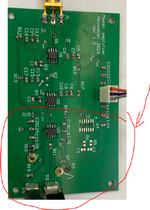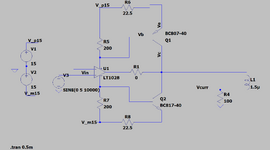yefj
Advanced Member level 4
Hello, I have the following circuit where the heart is the BJT.when i put the resistor to be 50Ohms i get a good sine current on the inductor L1 shown below.
But when i put 25 ohms i get compression .
In the compressed version i see that the current going threw the inductor is much higher and it seems like for input voltage of 3.8V the current reaches its maximum and going threw a compression.
does the current compression situation happens because the PNP NPN switch threw other states?
What is the logic of the cause the current threw L1 gets compressed?
Thanks.



But when i put 25 ohms i get compression .
In the compressed version i see that the current going threw the inductor is much higher and it seems like for input voltage of 3.8V the current reaches its maximum and going threw a compression.
does the current compression situation happens because the PNP NPN switch threw other states?
What is the logic of the cause the current threw L1 gets compressed?
Thanks.

